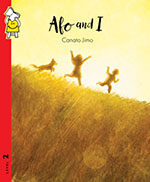Things are changing…’
These words from the book offer a beautiful summary of the story that is Afo and I. At its heart is Vinoka and Afo’s sibling relationship. Jimo superimposes Vinoka’s feelings about his sister Afo moving away with changes happening in their landscape. This becomes an entry point for readers to explore migration, habitat alteration, and the idea of home.The story progresses as Vinoka navigates fears linked to changes in his life, and how he makes peace with these changes.
From the start, Vinoka’s feelings rub off on us too. There is hurry. There is fear. There is worry. Jimo creates this impact with the speed of his words. They are short and crisp. They help us leap into the next page. Vinoka’s worries and anxieties give way to possibilities as the story builds up—writing letters, travelling to meet Afo. Although physical distances are increasing, the siblings can stay connected. So, there are ways to live with changes. For Vinoka, for the reader.
A non-linear narrative form adds to the story’s pace. Grasping different feelings, there is much back and forth for Vinoka. There is a present—Vinoka taking a short cut to reach Afo. There is a past flashback of the siblings engaged in different activities together. There are moments of rhetoric—Will Afo miss Vinoka? What is a city like? And towards the end is a hint at the future—Afo will miss Vinoka. For those learning to read, a non-linear narrative can be unfamiliar territory. Especially if one is familiar only with linear, start-to-end forward moving stories.
Jimo’s illustrations link the personal changes in Vinoka’s family to the macro changes in their landscape. Sometimes, when the text is referring to Vinoka’s feelings about his sister moving away, the illustration shows an altered landscape as a background to this text. Thus, the illustrations nuance the words, adding layers of meanings. Jimo utilizes contrast effectively to depict difference or change. For instance, skyscrapers towering over pointy, leafless trees. The sharp lines of these elements add to the mood of unpredictability as Vinoka tries to imagine what a city is like. Turning the page, we find Vinoka standing under the green shade of a tree, near its big bark. He is overlooking a settlement of houses on rolling hills. The imagery is softer, not pointy. It shows a landscape which is familiar to Vinoka. A cushioning against the changes he is grappling with.
Afo and I is a heartfelt read about siblings; about a small child experiencing big transitions. Through the themes of migration to the city and cutting of trees, change is shown as voluntary or forced. Yet, one can find ways to persevere. The book closes with Vinoka finding acceptance amidst the changes. And the readers get a name for Vinoka’s unsettled feeling—‘miss’.
November 2023, volume 47, No 11

